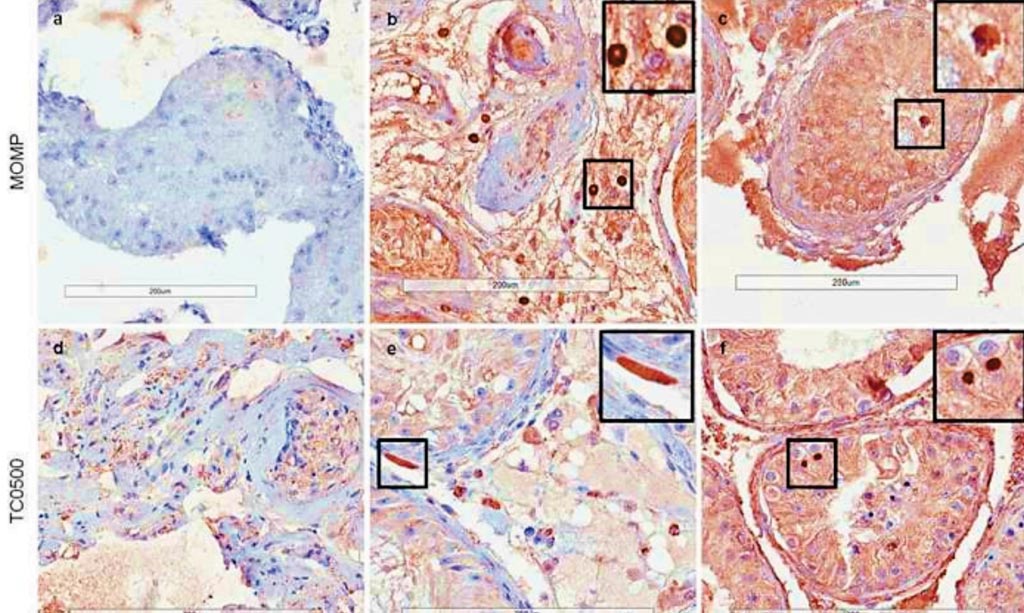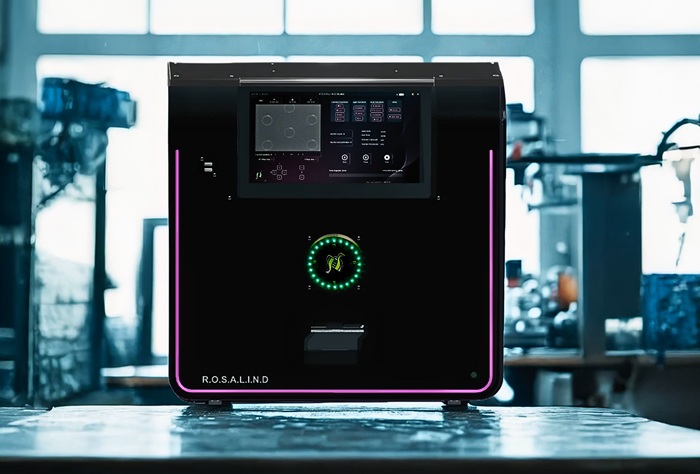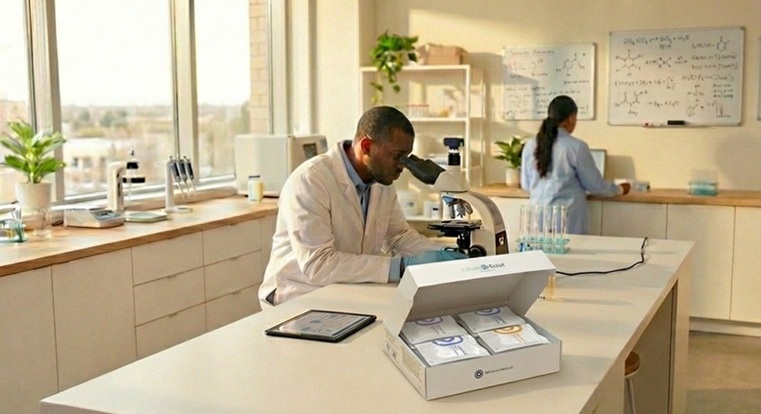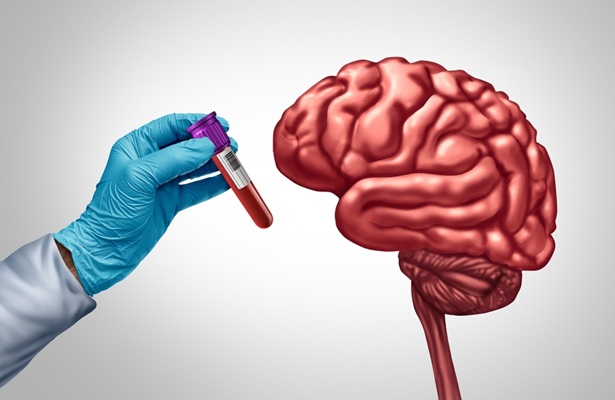Chlamydia in Testicular Tissue Linked to Male Infertility
|
By LabMedica International staff writers Posted on 26 Oct 2019 |

Image: The histological detection of chlamydia in human testicular biopsies (Photo courtesy of Queensland University of Technology).
Infectious diseases, such as mumps virus infection of the human testis, are known to play a role in spermatogenic dysfunction and have been associated with abnormal sperm parameters. Bacteria including Escherichia coli, mycoplasmas and Chlamydia trachomatis in human semen are also associated with abnormal sperm parameters.
The potential impact of undiagnosed sexually transmitted chlamydia infection on men's fertility has been highlighted in a study, which for the first time found chlamydia in the testicular tissue biopsies of infertile men whose infertility had no identified cause. Challenges in attributing male infertility to chlamydia infection include a wide diversity in diagnostic approaches.
Biomedical scientists at the Queensland University of Technology (Herston, Australia) collected 100 diagnostic (fixed) and 18 therapeutic (fresh) human testicular biopsies during sperm recovery procedures from moderately to severely infertile men in a cross-sectional approach to sampling. Two chlamydial markers were detected: the general marker major outer membrane protein (MOMP) and the active replication marker TC0500. Sections of 4 μm were dewaxed and rehydrated using a Leica ST5010-CV5030 Integrated Workstation.
The slides were processed and staining was validated using primary antibody only, secondary antibody only and DAB only controls. Stained slides were scanned using Leica Biosystems’ Aperio AT Turbo. QIAamp DNA FFPE Tissue Kit was used to extract DNA from fixed biopsies. C. trachomatis 16S rRNA DNA was detected using real-time polymerase chain reaction. Serum samples matched to fresh biopsies were assayed for C. trachomatis-specific antibodies.
The scientists reported that Chlamydia was found in 43/95 men (45.3 %) of fixed testicular biopsies, and all the men in this group had no defined cause of infertility. Chlamydia was also found in 3/18 men (16.7 %) of fresh testicular biopsies, obtained during patient sperm recovery procedures. These three men, and another 10 in the group, had no identified cause for their infertility. In 12 of the 18 men providing the fresh biopsies (66.7%) Chlamydia trachomatis-specific antibodies were found in serum, indicating the men had been exposed to the bacteria, but all were asymptomatic and said they had not been diagnosed with any sexually transmitted infection.
Kenneth W. Beagley, PhD, a Professor of Immunology and a senior author of the study said, “Chlamydia infection has been associated with women's infertility but much less is known about its impact on male infertility, particularly if men do not experience symptoms, which is estimated to be in about 50% of cases. When people have no symptoms they can unknowingly pass on the infection to sexual partners. This is the first reported evidence of Chlamydia infection in human testicular tissue, and while it can't be said that Chlamydia was the cause of the infertility of the men, it is a significant finding. It reveals a high rate of previously unrecognized Chlamydia infection and the potential role of infection in the failure of sperm to develop in the testes.” The study was published on October 4, 2019, in the journal Human Reproduction.
Related Links:
Queensland University of Technology
The potential impact of undiagnosed sexually transmitted chlamydia infection on men's fertility has been highlighted in a study, which for the first time found chlamydia in the testicular tissue biopsies of infertile men whose infertility had no identified cause. Challenges in attributing male infertility to chlamydia infection include a wide diversity in diagnostic approaches.
Biomedical scientists at the Queensland University of Technology (Herston, Australia) collected 100 diagnostic (fixed) and 18 therapeutic (fresh) human testicular biopsies during sperm recovery procedures from moderately to severely infertile men in a cross-sectional approach to sampling. Two chlamydial markers were detected: the general marker major outer membrane protein (MOMP) and the active replication marker TC0500. Sections of 4 μm were dewaxed and rehydrated using a Leica ST5010-CV5030 Integrated Workstation.
The slides were processed and staining was validated using primary antibody only, secondary antibody only and DAB only controls. Stained slides were scanned using Leica Biosystems’ Aperio AT Turbo. QIAamp DNA FFPE Tissue Kit was used to extract DNA from fixed biopsies. C. trachomatis 16S rRNA DNA was detected using real-time polymerase chain reaction. Serum samples matched to fresh biopsies were assayed for C. trachomatis-specific antibodies.
The scientists reported that Chlamydia was found in 43/95 men (45.3 %) of fixed testicular biopsies, and all the men in this group had no defined cause of infertility. Chlamydia was also found in 3/18 men (16.7 %) of fresh testicular biopsies, obtained during patient sperm recovery procedures. These three men, and another 10 in the group, had no identified cause for their infertility. In 12 of the 18 men providing the fresh biopsies (66.7%) Chlamydia trachomatis-specific antibodies were found in serum, indicating the men had been exposed to the bacteria, but all were asymptomatic and said they had not been diagnosed with any sexually transmitted infection.
Kenneth W. Beagley, PhD, a Professor of Immunology and a senior author of the study said, “Chlamydia infection has been associated with women's infertility but much less is known about its impact on male infertility, particularly if men do not experience symptoms, which is estimated to be in about 50% of cases. When people have no symptoms they can unknowingly pass on the infection to sexual partners. This is the first reported evidence of Chlamydia infection in human testicular tissue, and while it can't be said that Chlamydia was the cause of the infertility of the men, it is a significant finding. It reveals a high rate of previously unrecognized Chlamydia infection and the potential role of infection in the failure of sperm to develop in the testes.” The study was published on October 4, 2019, in the journal Human Reproduction.
Related Links:
Queensland University of Technology
Latest Microbiology News
- New UTI Diagnosis Method Delivers Antibiotic Resistance Results 24 Hours Earlier
- Breakthroughs in Microbial Analysis to Enhance Disease Prediction
- Blood-Based Diagnostic Method Could Identify Pediatric LRTIs
- Rapid Diagnostic Test Matches Gold Standard for Sepsis Detection
- Rapid POC Tuberculosis Test Provides Results Within 15 Minutes
- Rapid Assay Identifies Bloodstream Infection Pathogens Directly from Patient Samples
- Blood-Based Molecular Signatures to Enable Rapid EPTB Diagnosis
- 15-Minute Blood Test Diagnoses Life-Threatening Infections in Children
- High-Throughput Enteric Panels Detect Multiple GI Bacterial Infections from Single Stool Swab Sample
- Fast Noninvasive Bedside Test Uses Sugar Fingerprint to Detect Fungal Infections
- Rapid Sepsis Diagnostic Device to Enable Personalized Critical Care for ICU Patients
- Microfluidic Platform Assesses Neutrophil Function in Sepsis Patients
- New Diagnostic Method Confirms Sepsis Infections Earlier
- New Markers Could Predict Risk of Severe Chlamydia Infection
- Portable Spectroscopy Rapidly and Noninvasively Detects Bacterial Species in Vaginal Fluid
- CRISPR-Based Saliva Test Detects Tuberculosis Directly from Sputum
Channels
Clinical Chemistry
view channel
Noninvasive Blood-Glucose Monitoring to Replace Finger Pricks for Diabetics
People with diabetes often need to measure their blood glucose multiple times a day, most commonly through finger-prick blood tests or implanted sensors. These methods can be painful, inconvenient, and... Read more
POC Breath Diagnostic System to Detect Pneumonia-Causing Pathogens
Pseudomonas aeruginosa is a major cause of hospital-acquired and ventilator-associated pneumonia, particularly in lung transplant recipients and patients with structural lung disease. Its ability to form... Read moreMolecular Diagnostics
view channel
World's First NGS-Based Diagnostic Platform Fully Automates Sample-To-Result Process Within Single Device
Rapid point-of-need diagnostics are of critical need, especially in the areas of infectious disease and cancer testing and monitoring. Now, a direct-from-specimen platform that performs genomic analysis... Read more
Rapid Diagnostic Breakthrough Simultaneously Detects Resistance and Virulence in Klebsiella Pneumoniae
Antibiotic resistance is a steadily escalating threat to global healthcare, making common infections harder to treat and increasing the risk of severe complications. One of the most concerning pathogens... Read moreHematology
view channel
MRD Tests Could Predict Survival in Leukemia Patients
Acute myeloid leukemia is an aggressive blood cancer that disrupts normal blood cell production and often relapses even after intensive treatment. Clinicians currently lack early, reliable markers to predict... Read more
Platelet Activity Blood Test in Middle Age Could Identify Early Alzheimer’s Risk
Early detection of Alzheimer’s disease remains one of the biggest unmet needs in neurology, particularly because the biological changes underlying the disorder begin decades before memory symptoms appear.... Read more
Microvesicles Measurement Could Detect Vascular Injury in Sickle Cell Disease Patients
Assessing disease severity in sickle cell disease (SCD) remains challenging, especially when trying to predict hemolysis, vascular injury, and risk of complications such as vaso-occlusive crises.... Read more
ADLM’s New Coagulation Testing Guidance to Improve Care for Patients on Blood Thinners
Direct oral anticoagulants (DOACs) are one of the most common types of blood thinners. Patients take them to prevent a host of complications that could arise from blood clotting, including stroke, deep... Read moreImmunology
view channel
Blood Test Could Identify Colon Cancer Patients to Benefit from NSAIDs
Colon cancer remains a major cause of cancer-related illness, with many patients facing relapse even after surgery and chemotherapy. Up to 40% of people with stage III disease experience recurrence, highlighting... Read moreBlood Test Could Detect Adverse Immunotherapy Effects
Immune checkpoint inhibitors have transformed cancer treatment, but they can also trigger serious immune-related adverse events that damage healthy organs and may become life-threatening if not detected early.... Read morePathology
view channel
AI Tool Simultaneously Identifies Genetic Mutations and Disease Type
Interpreting genetic test results remains a major challenge in modern medicine, particularly for rare and complex diseases. While existing tools can indicate whether a genetic mutation is harmful, they... Read more
Rapid Low-Cost Tests Can Prevent Child Deaths from Contaminated Medicinal Syrups
Medicinal syrups contaminated with toxic chemicals have caused the deaths of hundreds of children worldwide, exposing a critical gap in how these products are tested before reaching patients.... Read more
Tumor Signals in Saliva and Blood Enable Non-Invasive Monitoring of Head and Neck Cancer
Head and neck cancers are among the most aggressive malignancies worldwide, with nearly 900,000 new cases diagnosed each year. Monitoring these cancers for recurrence or relapse typically relies on tissue... Read moreTechnology
view channel
Diagnostic Chip Monitors Chemotherapy Effectiveness for Brain Cancer
Glioblastoma is one of the most aggressive and fatal brain cancers, with most patients surviving less than two years after diagnosis. Treatment is particularly challenging because the tumor infiltrates... Read more
Machine Learning Models Diagnose ALS Earlier Through Blood Biomarkers
Amyotrophic lateral sclerosis (ALS) is a rapidly progressive neurodegenerative disease that is notoriously difficult to diagnose in its early stages. Early symptoms often overlap with other neurological... Read moreIndustry
view channel
BD and Penn Institute Collaborate to Advance Immunotherapy through Flow Cytometry
BD (Becton, Dickinson and Company, Franklin Lakes, NJ, USA) has entered into a strategic collaboration with the Institute for Immunology and Immune Health (I3H, Philadelphia, PA, USA) at the University... Read more






















